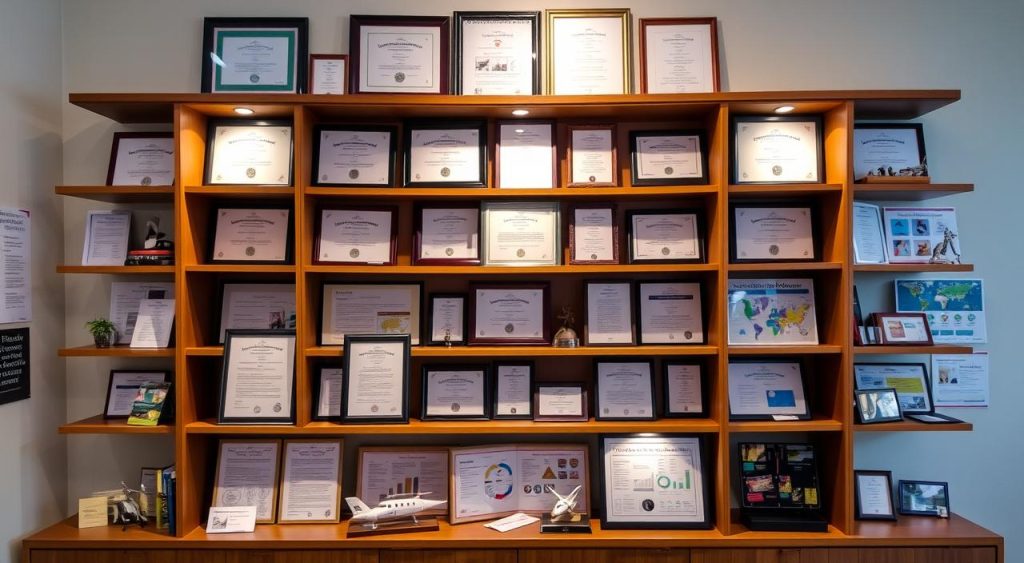In today’s job market, 70% of employers value a professional portfolio as much as a resume. This tool boosts your professional growth and opens up more employment options. It shows off your skills, achievements, and experiences, essential for career advancement.
A professional portfolio tells the story of your education and career. It’s more than a document; it’s a marketing tool. It can lead to new skill development opportunities, jobs, and career growth.
To create a standout portfolio, you need to blend personal branding with your work and education. It’s a living document that tracks your progress and shows your dedication to excellence. Let’s start building a portfolio that tells your story well, making you stand out in the job market.
Understanding the Importance of a Professional Portfolio
A professional portfolio is a key tool for career development. It shows your skills, experiences, and professional values. It’s not just a collection of documents but a strategic asset for finding jobs and advancing in academic advancement.
By showcasing your achievements and work samples, a portfolio shows your commitment to your field. It proves you can meet and exceed industry standards.
In today’s job market, a well-organized portfolio can set you apart. It lets employers and schools see your past work and potential. It also shows your ability to adapt and grow, which is vital for personal and professional development.
Using a portfolio as part of your professional strategy can improve your skills. It shows your commitment to learning and getting better, which employers and schools find attractive.
| Benefits | Impact on Career |
|---|---|
| Demonstrates professional dedication | Increases job marketability |
| Highlights continuous learning | Supports career development goals |
| Organizes and displays achievements | Enhances applications for academic programs |
A professional portfolio is more than just past achievements. It’s a tool for facing future challenges and opportunities in academic advancement and career growth. Whether you’re experienced or just starting, a well-made portfolio can give you a big advantage in your field.
The Essential Elements of a Strong Portfolio
A strong portfolio is more than just your past work. It shows your growth, skills, and ongoing learning. It matters whether you’re new or experienced in your field. Each part of your portfolio should clearly show what you can do and what you aim to achieve.
Highlighting Your Best Work
Choosing projects that show your skills and creativity is key. These should highlight your technical skills, problem-solving, and innovation. This selection lets others see your top achievements and your commitment to quality.
Including Testimonials and References
Feedback from respected people or happy clients adds credibility. It proves your dedication to quality and reliability. This makes you more attractive for future jobs or projects.
Detailing Your Skills and Experience
Being clear about your skills and experience is important. Show your education and any certifications you have. This section should clearly list your abilities, so others can quickly see your level of expertise.
| Category | Description | Impact on Professional Growth |
|---|---|---|
| Project Highlights | Selected works that demonstrate high levels of skill and innovation | Positions you as an expert in your field, attracting potential career opportunities |
| Testimonials | Positive feedback from industry peers and clients | Enhances credibility and trustworthiness in the professional community |
| Skills and Certifications | Detailed list of professional capabilities and educational achievements | Signifies commitment to continuous skill development and adaptation |
Choosing the Right Platform for Your Portfolio
Choosing where to host your professional portfolio is crucial. It can greatly impact your career and personal brand. This decision is even more important if you’re in vocational training or looking for new job opportunities. The right platform showcases your skills and supports your long-term career goals.
Online Portfolio Websites
Online portfolio websites are popular for showing off professional work. They are easy to use and can be customized. Whether you’re a graphic designer, writer, or engineer, these sites offer templates and tools to showcase your skills.
The Power of Personal Branding with Your Own Domain
Having your own domain for your portfolio boosts your personal brand. It shows a polished and professional online image. Plus, you have full control over your content, allowing you to adapt as your career grows or new opportunities arise. This choice can significantly impact how you’re seen in your industry.
Here’s a comparison of some platforms based on their features:
| Platform | Customization | Control | Cost | SEO Benefits |
|---|---|---|---|---|
| Standard Portfolio Site | High | Low | Free – Moderate | Low |
| Custom Domain | Very High | Very High | Moderate – High | High |
How to Showcase Your Educational Background
It’s important to highlight your formal education. This shows you have a strong foundation in both theory and practice in your field. It not only shows your academic growth but also your professional journey. You can use many learning resources to show this.
Displaying Academic Achievements
Academic achievements are the core of your educational showcase. Include diplomas, certificates, honors, and awards from your studies. These prove your hard work and ability to excel academically.
- Bachelor’s or Master’s degrees
- Dean’s list or other honors
- Academic competition awards
- Research grants or fellowships
Presenting Relevant Coursework and Projects
Highlight specific courses and projects that relate to your field. This part of your portfolio shows your specialized knowledge and skills. It demonstrates how you apply what you’ve learned to solve real-world problems.
| Course | Key Projects | Skills Acquired |
|---|---|---|
| Advanced Data Analysis | Market Trend Visualization | Statistical analysis, data interpretation |
| UI/UX Design Principles | App Interface Redesign | User-centric design, Adobe XD |
| Modern Architectural Theory | Eco-Friendly Housing Model | Environmental sustainability, design innovation |

By showing off your academic background in detail, you prove your qualifications. This can help you grow professionally. It uses your academic achievements as a stepping stone for future career opportunities.
Incorporating Professional Experience and Case Studies
A well-made portfolio can really help your career development and make you more visible in the job market. By showing off your professional experiences and case studies, you show you’re skilled and have many employment options.
Detailing Relevant Job Roles
When you describe your past jobs, show how you’ve grown and what you’ve achieved. It’s important to list your duties and any big wins that help you reach your career goals.
Using Case Studies to Demonstrate Problem-Solving Skills
Case studies are great for showing how you use what you know in real life. They’re key for moving up in your career development. They should show the problems you’ve solved, how you solved them, and the results you got.
| Project | Problem Addressed | Solution Developed | Outcome Achieved |
|---|---|---|---|
| Revenue Growth for E-commerce | Stagnant sales growth | Integrated new digital marketing strategies | 30% increase in quarterly sales |
| Operational Efficiency Improvement | High operational costs and time delays | Implemented lean management techniques | Reduced costs by 20% and improved delivery time by 25% |
| Customer Service Enhancement | Poor customer feedback and engagement | Developed a comprehensive customer feedback system | Improved customer satisfaction scores by 40% |
By using your job experiences and case studies well, your portfolio shows you’re ready for more. It opens up more job prospects and employment options for you.
Emphasizing Continuing Education and Career Development
In today’s fast-changing job market, continuous learning is key. Professionals who get professional certifications and keep learning show they’re serious about staying sharp. This makes them stand out and stay competitive.
Listing Professional Certifications and Courses
Professional certifications are more than just papers. They show a person’s hard work and skill in certain areas. For example, a certification in project management or digital marketing can make a person more attractive to employers.
Participating in Workshops and Seminars
Going to workshops and seminars is a great way to keep learning. These events give you the latest info on your field and help you meet people. Showing up to these events shows you’re serious about growing your career.
| Year | Event Type | Focus Area | Benefits |
|---|---|---|---|
| 2023 | Workshop | Emerging Technologies | New skills, networking |
| 2024 | Seminar | Leadership | Leadership skills, industry insights |
| 2025 | Online Course | Data Analysis | Technical skills, certification |
Utilizing Multimedia to Make Your Portfolio Interactive
Adding multimedia to your portfolio can make it more appealing and useful. By using videos, infographics, and interactive slideshows, you show off your technical skills. You also show you’re ready for the digital world.
These multimedia elements do more than look good. They show how you can solve problems in real life. They let employers or clients see your skills in action. This is a strong way to show you’re ready for the job.
Using rich media also helps people learn in different ways. This makes your portfolio more accessible to everyone. It helps keep people interested in what you have to offer.
| Media Type | Benefits | Examples |
|---|---|---|
| Video | Shows dynamism and ability to handle multimedia projects | Project walkthroughs, personal introductions |
| Interactive Presentations | Engages the viewer, improving retention of information presented | Slides with clickable elements, animated stats |
| Infographics | Condenses complex data into digestible visual content | Market trends, workflow processes |
By adding multimedia to your portfolio, you grab people’s attention. You also show you can communicate well on different platforms. This is a key skill in many jobs. It shows you’re ready for the future and can use new tools to tell your story.
Strategies for Regular Portfolio Maintenance and Updates
Keeping your professional portfolio up-to-date is key to showing your career development and skill development. It helps you stay relevant and make a strong impression. Here are some tips to keep your portfolio fresh:
Setting a Revision Schedule
It’s important to set a regular update schedule for your professional portfolio updates. This could be every quarter, every six months, or once a year. This ensures your portfolio stays current with your career and skills.
Keeping Content Fresh and Relevant
Also, make sure the content in your portfolio is still relevant. As you grow in your career, some projects might not show your current skills. Update your portfolio to showcase your latest work and skills. This shows you’re committed to staying current in your field.
| Update Frequency | Content Focus | Benefits |
|---|---|---|
| Quarterly | New skills and projects | Shows continual growth and adaptability |
| Semi-annually | Major achievements and roles | Highlights career milestones and leadership |
| Annually | Comprehensive review and overhaul | Ensures complete alignment with career objectives |

Networking and Promoting Your Portfolio
Creating a great portfolio is a big step in your career. But, the real secret is in networking and promotion. Being active in your professional world and showing your portfolio everywhere can really help you grow. It can also open new doors for your career.
Being part of both online and offline professional groups is key. Whether it’s on social media or at networking events, each chance is an opportunity to grow. It helps you expand your network and move your career forward.
- Join industry groups and online forums.
- Go to conferences and workshops to meet people.
- Use social media to share your successes.
Building relationships helps you get noticed and improves your reputation. As you connect with others, you both share knowledge and find new chances. This way, you help and are helped by others in your field.
Putting your portfolio and networking together speeds up your career. Every time you meet someone or go to an event, you have a chance to show off your skills. Take these chances to build strong relationships that help your career development.
Leveraging Education and Career Opportunities
In today’s job market, linking your portfolio with platforms like LinkedIn is key for career growth. Knowing how to boost your portfolio with education can make you stand out.
Connecting Portfolio to LinkedIn
LinkedIn is crucial for connecting your portfolio with many job chances. By linking your portfolio to LinkedIn, you show a clear story of your career. This makes you more attractive to employers, showing you’re serious about your work.
Using Educational Opportunities to Enhance Your Portfolio
Certifications, workshops, and seminars are more than learning; they show your dedication to growth. Adding these to your portfolio can greatly improve your professional image. It shows you’re up-to-date in your field.
By documenting these educational steps in your portfolio, you make it richer and more valuable. It proves you’re always learning and adapting in your career.
Examples of Impressive Portfolios in Diverse Industries
Looking at successful portfolios in different fields shows the power of presentation. It also shows how portfolios help in job hunting, learning new skills, and training. These examples inspire and teach us how to make a portfolio that stands out and looks professional.
Technology Sector: In the fast-changing tech world, people show off their tech skills and creative projects in their portfolios. These portfolios focus on solving problems, mastering programming, and keeping up with new tech.
Creative Arts: Artists and designers create eye-catching portfolios that show their style and creativity. These portfolios are key for showing their unique vision and talent, which helps them succeed in their careers.
Education and Training: Teachers and trainers share their teaching methods and successes in their portfolios. They include lesson plans, workshop details, and feedback from students. This shows how well they teach and improve skills.
Business: In marketing and finance, portfolios prove a person’s ability to grow businesses through smart planning and project success. They include market analysis, campaign results, and a story of growing responsibilities and achievements.
Engineering: Engineers showcase their project work, technical drawings, and software skills. This shows their analytical and problem-solving abilities. It helps them stand out in job applications and training.
Looking at these different portfolios shows how useful they are in many fields. It shows how a well-made portfolio can greatly help in finding jobs and growing a career in various industries.
Conclusion
A well-made professional portfolio is key to showing your career path and goals. It’s not just a collection of past work. It links your education to career growth. With careful updates, it shows your dedication to learning and moving forward in your field.
Having a strong portfolio can really help you grab education and career opportunities. It shows your best work, your education story, and your ongoing learning. Your professional portfolio should grow with you, showing all you’ve learned and done.
By using the tips from earlier, your portfolio is more than just achievements. It’s a part of who you are professionally. See your professional portfolio as a way to invest in your future. It shows where you’ve been and where you’re going, opening doors to new education and career opportunities.



